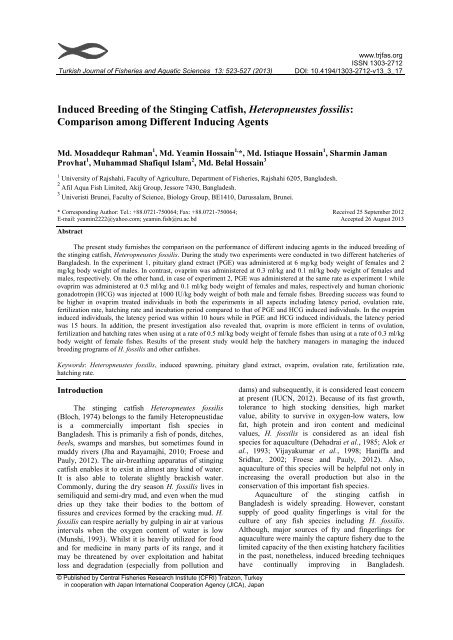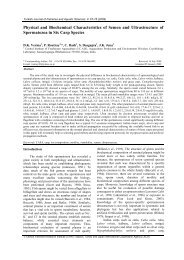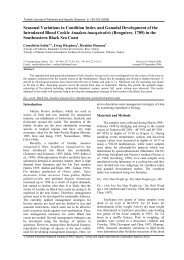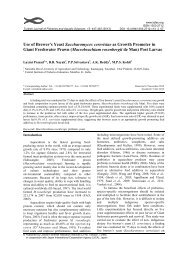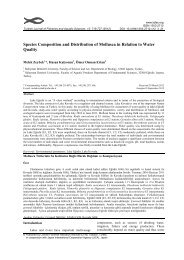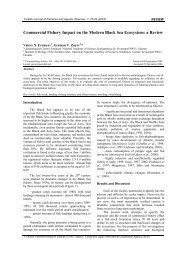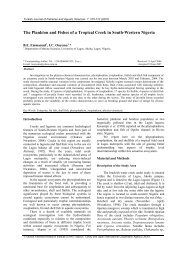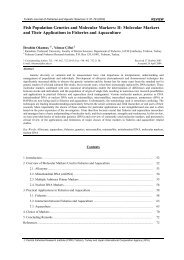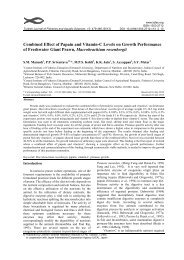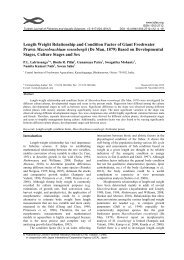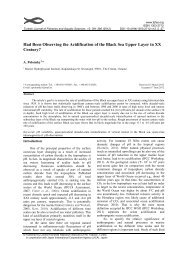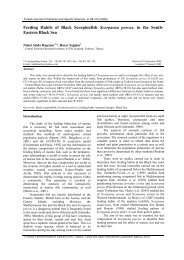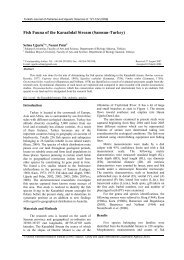Induced Breeding of the Stinging Catfish, Heteropneustes fossilis ...
Induced Breeding of the Stinging Catfish, Heteropneustes fossilis ...
Induced Breeding of the Stinging Catfish, Heteropneustes fossilis ...
You also want an ePaper? Increase the reach of your titles
YUMPU automatically turns print PDFs into web optimized ePapers that Google loves.
524 M. Rahman et al. / Turk. J. Fish. Aquat. Sci. 13: 523-527 (2013)Subsequently, at present, hatchery producedfry/fingerlings become <strong>the</strong> major sources <strong>of</strong> seed for<strong>the</strong> aquaculture industry in <strong>the</strong> country. While <strong>the</strong>production <strong>of</strong> fish seed from hatchery sources hasincreased dramatically, <strong>the</strong> quality has not improvedowing to poor hatchery management practicesresulting deleterious effects such as negativeselection, inbreeding depression, indiscriminateinterspecific hybridization etc.Although a few studies on <strong>the</strong> induced breeding<strong>of</strong> H. <strong>fossilis</strong> are available including effects <strong>of</strong> carppituitary gland extract, human chorionic gonadotropinand syn<strong>the</strong>tic hormone (ovaprim) doses on inducedbreeding, maturation and ovulation <strong>of</strong> H. <strong>fossilis</strong>(Alok et al., 1993; Begum et al., 2001; Nayak et al.,2001; Haniffa and Sridhar, 2002; Haniffa et al.,2002), however, detailed studies on <strong>the</strong> inducedbreeding <strong>of</strong> H. <strong>fossilis</strong> are clearly missing inBangladesh. Subsequently, <strong>the</strong> present study furnishesinformation on <strong>the</strong> comparative performances <strong>of</strong>different inducing agents on <strong>the</strong> breeding success <strong>of</strong>H. <strong>fossilis</strong>.Materials and MethodsStudy SiteThe present study was conducted at two fishhatcheries in Feni and Jessore districts <strong>of</strong>Bangladesh during February 2010 to July2010 (experiment 1 in Feni) and March 2012 toAugust 2012 (experiment 2 in Jessore).Brood CollectionThe brood fish for <strong>the</strong> artificial breeding <strong>of</strong> H.<strong>fossilis</strong> were obtained from <strong>the</strong> respective fishhatcheries. A total <strong>of</strong> 30 brooders in each experimentwere stocked in each hatchery collected from <strong>the</strong> wildstocks. All <strong>the</strong> brood stocks were acclimatized before<strong>the</strong> induced breeding procedures and were keptseparately in ponds <strong>of</strong> 14.3 × 8.15 × 1.5 m. inexperiment 1 and 15 × 9.65 × 1.5 m. in experiment 2for four months before <strong>the</strong> start <strong>of</strong> <strong>the</strong> breedingseason.Brood Stock ManagementThe brood fishes were fed on supplementary dietformulated from 25% fish meal, 20% rice bran, 20%wheat flour, 15% mustard oil cake, 4% molasses and1% vitamin premix. The brooders were reared for fourmonths with feeding at two times a day at <strong>the</strong> rate <strong>of</strong>5-6% <strong>of</strong> <strong>the</strong> body weight in both <strong>the</strong> experiments. Inaddition, <strong>the</strong> ponds were treated with animal manureat 15 days interval at <strong>the</strong> rate <strong>of</strong> 1250 kg/hectare.Fur<strong>the</strong>rmore, inorganic fertilizers namely Urea andTriple Super Phosphate (TSP) were applied at <strong>the</strong> rate<strong>of</strong> 50 kg/hectare and 25 kg/hectare, respectively.Brood Selection and ConditioningBrood fish were collected from <strong>the</strong> rearingponds using a cast net in <strong>the</strong> morning between 8:00-9:00 am on <strong>the</strong> day <strong>of</strong> <strong>the</strong> breeding trials andimmediately transferred to circular tanks in respectivehatcheries. The males and females were kept inseparate tanks and continuous water flows weresustained at a rate <strong>of</strong> 10 l/min. Water qualityparameters were found as- dissolved oxygen: 5.2-5.7ppm; CO 2 : 4.6-5.8 ppm; pH: 7.3-8.5; temperature: 27– 30 °C in experiment 1 while in case <strong>of</strong> experiment 2water quality parameters were recorded as- dissolvedoxygen: 5.4-6.2 ppm; CO 2 : 4.2-6.1 ppm; pH: 7.1-8.2;temperature: 26.5-29°C. However, no supplementaryfeed were provided throughout <strong>the</strong> conditioningperiod.Brood Stock Injection and <strong>Breeding</strong> <strong>Induced</strong>Commercially available dehydrated carppituitary gland extracts (PGE) and syn<strong>the</strong>tic hormoneovaprim were used in experiment 1 whereasdehydrated carp pituitary gland extracts (PGE),syn<strong>the</strong>tic hormone ovaprim and human chorionicgonadotropin (HCG) were used in experiment 2. Thebody weight (g) <strong>of</strong> each brooder was weighed on anelectronic balance (College B204-S, Switzerland) toestimate <strong>the</strong> required amount <strong>of</strong> inducing agents.The brooders were divided into two groupsconsisting <strong>of</strong> three females and five males <strong>of</strong> H.<strong>fossilis</strong> each in both experiments, and <strong>the</strong>n subjectedto hormone treatment. In experiment 1, one group wasinjected using PGE (6 mg/kg body weight <strong>of</strong> femalesand 2 mg/kg body weight <strong>of</strong> males) and <strong>the</strong> secondgroup using ovaprim hormone (0.3 ml/kg and 0.1ml/kg body weight <strong>of</strong> females and males,respectively) in <strong>the</strong> hatchery situated at Feni. On <strong>the</strong>o<strong>the</strong>r hand, in experiment 2, one group was injectedusing PGE (6 mg/kg body weight <strong>of</strong> females and 2mg/kg body weight <strong>of</strong> males), <strong>the</strong> second group usingovaprim hormone (0.5 ml/kg and 0.1 ml/kg bodyweight <strong>of</strong> females and males, respectively) and <strong>the</strong>third group using HCG (1000 IU/kg body weight <strong>of</strong>both male and female fish) in <strong>the</strong> hatchery situated atJessore. For all <strong>the</strong> treatments, <strong>the</strong> hormone wasadministered by intra-muscular injection on musclesbeneath <strong>the</strong> dorsal fin slightly above <strong>the</strong> lateral line.After injection, <strong>the</strong> brooders were kept in separatebreeding tanks for each treatment.<strong>Breeding</strong> and Egg Transfer for IncubationAll <strong>the</strong> brooders were ovulated after a period <strong>of</strong>10-15 hrs after injection in both <strong>the</strong> experiments. Thebrooders were <strong>the</strong>n transferred from <strong>the</strong> holding tanksafter <strong>the</strong> completion <strong>of</strong> ovulation. Whereas, <strong>the</strong>fertilized eggs were transferred into mini rectangularhatching trays with taking precaution to avoid damageand fungal/bacterial contamination during <strong>the</strong> egg
M. Rahman et al. / Turk. J. Fish. Aquat. Sci. 13: 523-527 (2013) 525collection. The number <strong>of</strong> eggs released into each traywas estimated using gravimetric methods adaptedfrom Legender (1986) and reviewed by Lagler (1992).Afterwards, a continuous flow <strong>of</strong> water wasmaintained for aeration to guarantee <strong>the</strong>environmental conditions were optimal for <strong>the</strong>hatching process.Determination <strong>of</strong> Ovulation, Fertilization andHatching RateOvulation rate, fertilization rate and hatching rateswere calculated using <strong>the</strong> following formula:Ovulation rate (%) = (No. <strong>of</strong> fish ovulated/ Total no.<strong>of</strong> fish injected) × 100Fertilization rate (%) = (No. <strong>of</strong> fertilized eggs/ Totalno. <strong>of</strong> eggs) × 100Hatching rate (%) = (No. <strong>of</strong> eggs hatched/ Total no. <strong>of</strong>fertilized eggs) × 100Statistical AnalysisStatistical analyses were performed usingGraphPad Prism 5 s<strong>of</strong>tware. Tests for normality <strong>of</strong>each group were conducted by visual assessment <strong>of</strong>histograms and box plots, and confirmed using <strong>the</strong>Kolmogorov-Smirnov test. Only percent data had tobe arcsine transformed before analysis. Where <strong>the</strong>normality assumption was not met, <strong>the</strong> nonparametricMann-Whitney U-test and Kruskal-Wallistest were used to compare <strong>the</strong> length and weight <strong>of</strong>fishes between groups and experiments. A Chi-squaretest was used to check <strong>the</strong> ovulation, fertilization andhatching rates between PGE, ovaprim and HCGtreated fishes. All statistical analyses were consideredsignificant at 5% (P
526 M. Rahman et al. / Turk. J. Fish. Aquat. Sci. 13: 523-527 (2013)Table 1. Showing details <strong>of</strong> induced breeding in <strong>Stinging</strong> <strong>Catfish</strong>, <strong>Heteropneustes</strong> <strong>fossilis</strong> using different inducing agentsInducingExperiment 1 Experiment 2Agent LP(hrs) OR (%) FR (%) HR (%) IP (hrs) LP(hrs) OR (%) FR (%) HR (%) IP (hrs)PG 15 78.67% 69.23% 72.72% 5.0 15 76.51% 70.45% 70.25% 5.0Ovaprim 10 90.00% 86.67% 76.92% 3.5 10 93.77% 90.83% 82.48% 3.5HCG --- --- --- --- --- 15 82.67% 75.33% 66.58% 5.0LP, Latency period; OR, Ovulation rate; FR, Fertilization rate; HR, Hatching rate; IP, Incubation period10080Experiment 1Experiment 2Percentage6040200Ovulation Fertilization HatchingFigure 1. Comparison on <strong>the</strong> performance <strong>of</strong> different doses (Exp. 1: 0.3 ml/kg body wt <strong>of</strong>female; Exp. 2: 0.5 ml/kg body<strong>of</strong> female) <strong>of</strong> <strong>the</strong> syn<strong>the</strong>tic hormone ovaprim in <strong>the</strong> induced breeding <strong>of</strong> <strong>Heteropneustes</strong> <strong>fossilis</strong>.ovaprim at 0.3 ml/kg and 0.5 ml/kg body weight as70% and 75%, respectively (Haniffa and Sridhar,2002). Fur<strong>the</strong>rmore, Begum et al. (2001) reported <strong>the</strong>highest rate <strong>of</strong> fertilization (98%) in H. <strong>fossilis</strong>injected by PGE at 75 mg/kg which is much higherthan that found in <strong>the</strong> present study <strong>of</strong> PGE injectedfishes. Such deviations in <strong>the</strong> fertilization rate can beattributed to <strong>the</strong> huge differences <strong>of</strong> hormonal doses,size <strong>of</strong> <strong>the</strong> brood fish, seasonal variation (Gheyas etal., 2002; Haniffa and Sridhar 2002; Nwokoye et al.,2007), environmental factors, water qualityparameters (alkalinity, DO, pH, hardness) (Khan etal., 2006). The quality <strong>of</strong> <strong>the</strong> PGE hormone may alsohave influencing impact on <strong>the</strong> fertilization rates.Hatching RatesIn case <strong>of</strong> experiment 1, <strong>the</strong> hatching rates werefound to be slightly higher (76.92%) for eggs in <strong>the</strong>ovaprim treated fishes compared to that <strong>of</strong> PGEtreated fishes (72.72%) (Table 1). However, chisquare test showed no significant differences inhatching rates between ovaprim and PGE treatedfishes. Moreover, <strong>the</strong> incubation period for eggs in <strong>the</strong>PGE treated fish was more than 1.5 h longer than <strong>the</strong>ovaprim treated fish. On <strong>the</strong> o<strong>the</strong>r hand, whenconsidering <strong>the</strong> experiment 2, fertilization rates werefound to be higher in ovaprim treated fishes (82.48%)compared to that <strong>of</strong> PGE and HCG treated fishes(Table 1). While comparing between experiments it isquite clear that hatchling rates were higher whenovaprim was used at a rate <strong>of</strong> 0.5 ml/kg body weight<strong>of</strong> female fish (experiment 2) (Figure 1). None<strong>the</strong>less,Nayak et al. (2001) reported a hatching period <strong>of</strong> 10-12 h in H. <strong>fossilis</strong> treated with ovaprim treatment at27±1º C and obtained higher hatching rate <strong>of</strong> 96%using ovaprim at <strong>the</strong> rate <strong>of</strong> 0.4 ml/kg body weight.Haniffa and Sridhar (2002) reported a hatching rate50.5% and 60% for H. <strong>fossilis</strong> injected with ovaprimat a rate <strong>of</strong> 0.3 ml/kg and 0.5 ml/kg body weight,respectively. However, in terms <strong>of</strong> hatchling rate,ovaprim treated fish yielded better results compared<strong>the</strong> PGE treated fish (Nandeesha et al., 1990; More etal., 2010). All <strong>the</strong>se studies to some extent support <strong>the</strong>findings <strong>of</strong> <strong>the</strong> present study.In conclusion, ovaprim treated brooders <strong>of</strong> H.<strong>fossilis</strong> showed better performance during inducedbreeding in both <strong>the</strong> experiments during <strong>the</strong> study.However, ovaprim was found to be more efficient interms <strong>of</strong> ovulation, fertilization and hatching rateswhen using at a rate <strong>of</strong> 0.5 ml/kg body weight thanusing at a rate <strong>of</strong> 0.3 ml/kg body weight <strong>of</strong> femalefishes. Results <strong>of</strong> <strong>the</strong> present study would bebeneficial for apposite management <strong>of</strong> inducedbreeding programs <strong>of</strong> H. <strong>fossilis</strong> and o<strong>the</strong>r catfishes.AcknowledgementsWe would like to give special thanks to (i) <strong>the</strong><strong>of</strong>fice staffs <strong>of</strong> <strong>the</strong> studied fish hatcheries for <strong>the</strong>ir
M. Rahman et al. / Turk. J. Fish. Aquat. Sci. 13: 523-527 (2013) 527cooperation during <strong>the</strong> present study, and (ii)anonymous referees for <strong>the</strong>ir useful and constructivecomments.ReferencesAlok, D., Krishnan, T., Talwar, G.P., Garg, L.C. 1993.<strong>Induced</strong> spawning <strong>of</strong> catfish, <strong>Heteropneustes</strong> <strong>fossilis</strong>(Bloch), using D-Lys 6 salmon gonadotropin-releasinghormone analog. Aquaculture 115(1-2): 159-167.doi: 10.1016/0044-8486(93)90366-7Begum, N., Rahaman, M.A., Hussain, M.G. and Mazid,M.A. 2001. “Effects <strong>of</strong> carp PG doses on inducedbreeding <strong>of</strong> shing, <strong>Heteropneustes</strong> <strong>fossilis</strong> (Bloch)”Bangladesh J. Fish. Res. 5(2): 145-148.Dehadrai, P.V., Yusuf, K.M. and Das, R.K., 1985. Package<strong>of</strong> practices for increasing production <strong>of</strong> air breathingfishes, p. 1-4. In Aquaculture Extension Manual.Information and Extension Division <strong>of</strong> CIFRI (ICAR),India. New Series. No. 3.Froese, R. and Pauly, D. (Eds). 2012. Fishbase 2012. WorldWide Web electronic publication. Available at:http://www.fishbase.org (Accessed on 23 June 2012).Gheyas, A.A., Islam, M.S., Mollah, M.F.A., and Hussain,M.G. 2002. A comparative study on <strong>the</strong> embryonicdevelopment <strong>of</strong> gynogen, triploid, haploid and normaldiploid <strong>of</strong> stinging catfish, <strong>Heteropneustes</strong> <strong>fossilis</strong>.Bangladesh J. Fish. Res. 6 (2): 107-115.Haniffa, M.A.K. and Sridhar, S. 2002. <strong>Induced</strong> spawning <strong>of</strong>spotted murrel (Channa punctatus) and catfish(<strong>Heteropneustes</strong> <strong>fossilis</strong>) using human chorionicgonadotropin and syn<strong>the</strong>tic hormone (Ovaprim). Vet.Archiv. 72: 51-56.IUCN, 2012. IUCN Red List <strong>of</strong> Threatened Species.Version 2012.1. IUCN 2012. IUCN Red List <strong>of</strong>Threatened Species. Downloaded in June 2012.Jha, B.R. and Rayamajhi, A. 2010. <strong>Heteropneustes</strong> <strong>fossilis</strong>.In: IUCN 2013. IUCN Red List <strong>of</strong> ThreatenedSpecies. Version 2013.1. www.iucnredlist.org.(Accessed on 19 May 2013).Khan, A.M., Shakir, H.A., Ashraf, M. and Ahmad, Z. 2006.<strong>Induced</strong> spawning <strong>of</strong> Labeo rohita using syn<strong>the</strong>tichormones. Punjab Univ. J. Zool. 21 (1-2): 67-72.Kohil, M.P.S. and Goswami, U.C. 1987. Spwaningbehaviour <strong>of</strong> a freshwater airbreathing Indian catfish<strong>Heteropneustes</strong> <strong>fossilis</strong> (Bloch). Matsya 12: 180–183.Lagler, K.F. 1982. Freshwater Fishery Biology. WM. C.Brown Company Publishers. Iowa, 2nd edn, pp.108-109.Legender, M. 1986. Seasonal changes in sexual maturityand fecundity and HCG induced breeding <strong>of</strong> <strong>the</strong>catfish <strong>Heteropneustes</strong> longifilis val. (Flarridae)reared in Ebrie lagoon (Ivory coast). Aquaculture 55:201–213. doi: 10.1016/0044-8486(86)90115-8More, P.R., Bhandare, R.Y., Shinde, S.E., Pathan T.S. andSonawane, D.L. 2010. Comparative Study <strong>of</strong>Syn<strong>the</strong>tic Hormones Ovaprim and Carp PituitaryExtract Used in <strong>Induced</strong> <strong>Breeding</strong> <strong>of</strong> Indian MajorCarps. Libyan Agric. Res. Cen. J. Intl. 1 (5): 288-295.Munshi, J.S.D. 1993. Structure and function <strong>of</strong> <strong>the</strong> airbreathing organs <strong>of</strong> <strong>Heteropneustes</strong> <strong>fossilis</strong>; inAdvances in fish research I (ed.) B R Singh (Delhi:Narendra Publishing House) pp.99-138.Nandeesha, M.C., Rao, K.G., Jayanna, R., Parker, N.C.,Varghese, T.J., Keshavanath, P. and Shetty, H.P.C.1990. <strong>Induced</strong> spawning <strong>of</strong> Indian Major carpsthrough single application <strong>of</strong> Ovaprim C., pp: 581-585. In Hirano, R and L. Hanyu (Eds.) The secondAsian Fisheries Forum, Asian Fisheries Society,Manila, Philiphines.Nayak, P.K., Mishra, T.K., Singh, B.N., Pandey A.K. andDas, R.C. 2001. <strong>Induced</strong> maturation and ovulation in<strong>Heteropneustes</strong> <strong>fossilis</strong> by using LHRHa , pimozideand Ovaprim for production <strong>of</strong> quality eggs, andlarvae. Indian J. Fish. 48(3): 269-275.Nwokoye, C.O., Nwuba, L.A. and Eyo, J.E. 2007. <strong>Induced</strong>propagation <strong>of</strong> African clariid catfish,Heterobranchus bidorsalis (Ge<strong>of</strong>frey Saint Hillarie,1809) using syn<strong>the</strong>tic and homoplastic hormones. Afr.J. Biotechnol. 6 (23): 2687-2693.Vijayakumar, C., Sridhar, S. and Haniffa, M.A. 1998. Lowcost breeding and hatching techniques <strong>of</strong> <strong>the</strong> catfish(<strong>Heteropneustes</strong> <strong>fossilis</strong>) for small-scale farmers.Naga 21: 15-17.


